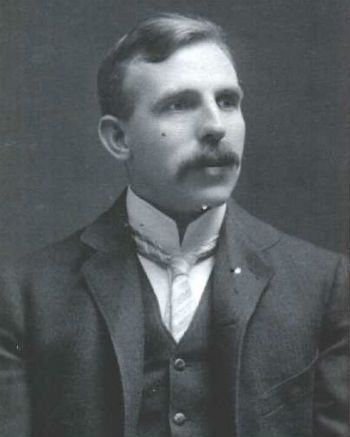Rutherford (1871-1937) was a New Zealand physicist. In 1899, researching uranium he discovered alpha radiation and beta radiation . It laid the foundations for the theory of radioactivity . He revolutionized atomic theory by developing the model called the planetary system , which in general is still valid today.
Life and work

Rutherford was born in Nelson, New Zealand, on August 30, 1871. He studied in his hometown. He attended the University of Wellington, where in 1893 he graduated in mathematics and physics. He won, by contest, a scholarship to the University of Cambridge, England.
In Cambridge he worked at the Cavendish Laboratory, under the guidance of JJ Thomson , the physicist who discovered electrons, where he did research on the movement of atomic particles or electrically charged molecules: ions .
He showed interest in the radiation emitted by the radio element , which had been recently discovered by Marie and Pierre Curie. In 1937 he was awarded the title of Lord.
Rutherford’s discoveries
In 1899, researching uranium at Mcgill University in Montreal, Canada, found that a type of radiation emitted by this element was easily blocked by a thin sheet of metal. He called it alpha rays , although he was still unaware of its nature.
Another form of radiation more penetrating and blocked with much greater thicknesses of matter, was called beta rays . Such discoveries were important for Rutherford’s future work with his colleague Frederick Soddy. Both laid the foundation for the theory of radioactivity .
Experiments with Alpha Particles
In 1907, Rutherford went to work in Manchester, England, when he discovered that alpha rays consisted of a flow of positively charged helium atoms, that is, without electrons.
This discovery was made by collecting the gas resulting from the passage of radioactive particles through the walls of a vacuum chamber. The gas was shown to be helium. This discovery earned him the Nobel Prize in Chemistry in 1908.
In 1910, Rutherford and his assistant Geiger placed a very thin gold leaf intercepting a beam of alpha particles with enough energy to penetrate through the leaf, which came from the spontaneous disintegration of natural radioactive elements.
It was observed that some particles were totally blocked, others were not affected, but most of them exceeded the leaf suffering deviations.
At the end of the whole process, he concluded that the material in the metal foil, like any material, is quite rarefied, that is, it consists almost entirely of empty spaces, the diameter being ten thousand times smaller than that of the entire atom. Such is the nucleated atom model, proposed by Rutherford and accepted today.
Rutherford Atomic Model
Rutherford inspired all modern atomic theory by stating that the atom was nucleated and its positive part was concentrated in an extremely small volume, which would be the nucleus itself.
The electrons would be extranuclear. The Rutherford Atomic Model corresponds to the miniature planetary system , in which the electrons – micro-satellites – move in circular or elliptical orbits around the nuclear micro-sun. Share Submit Email
